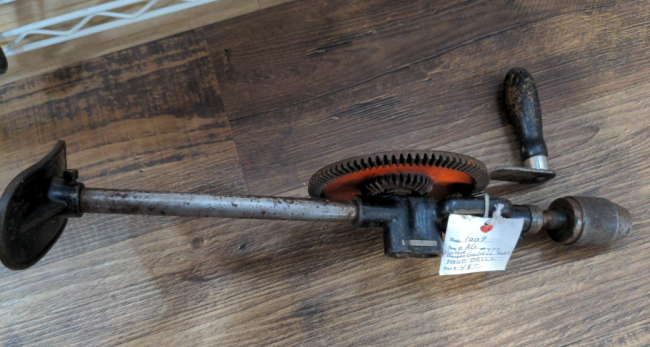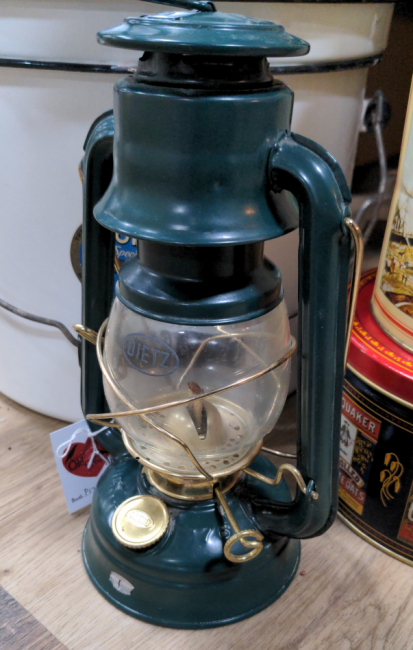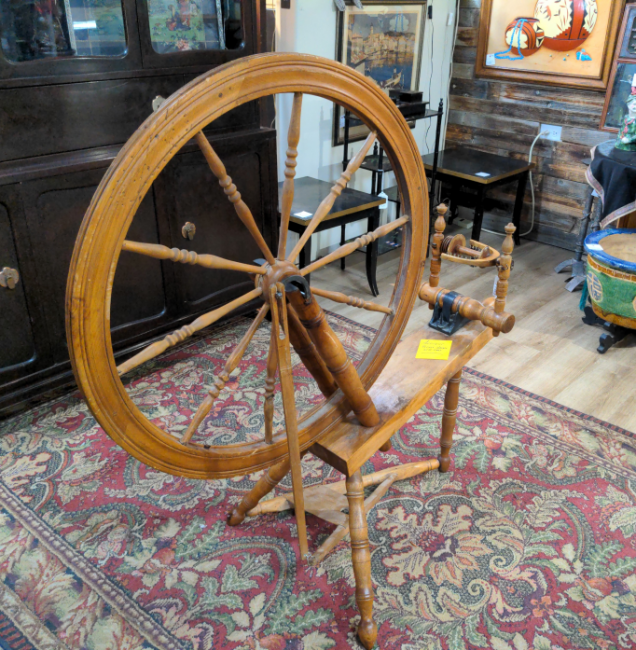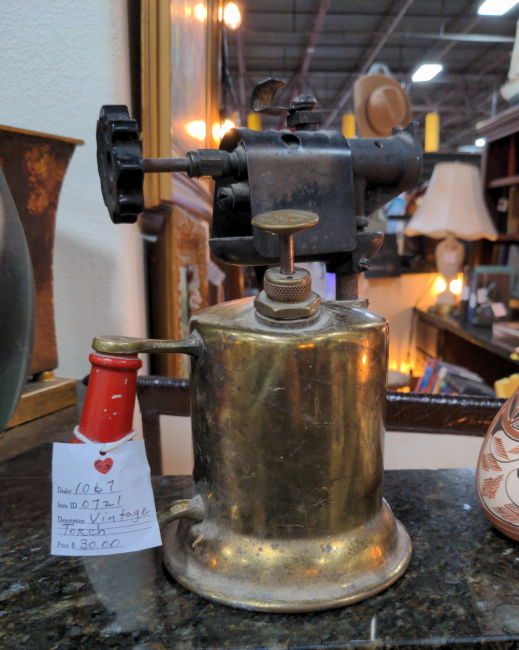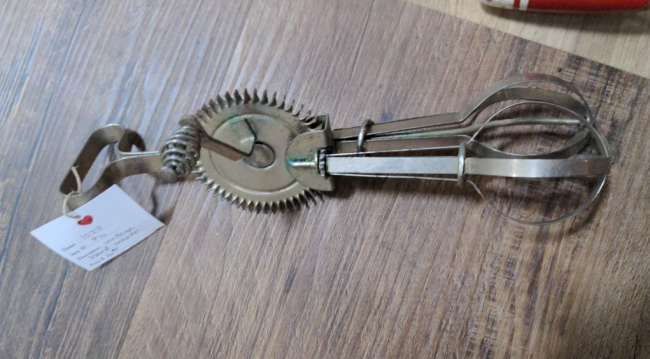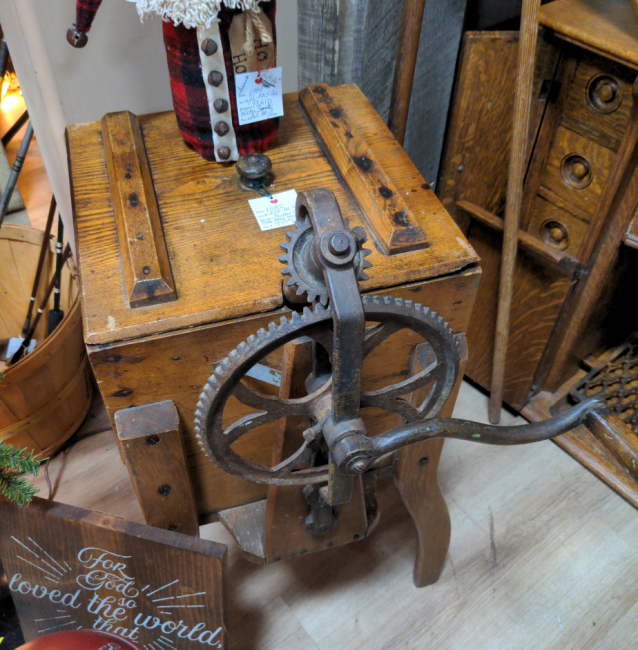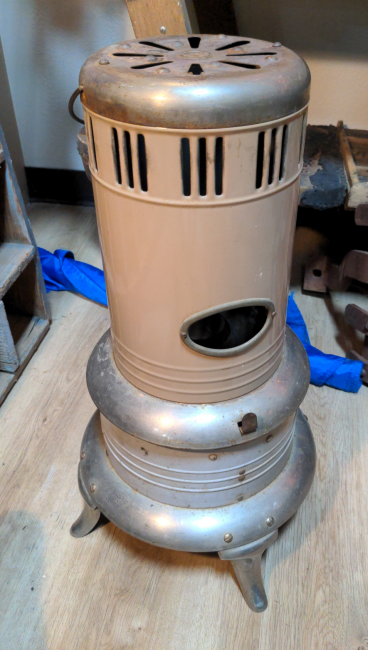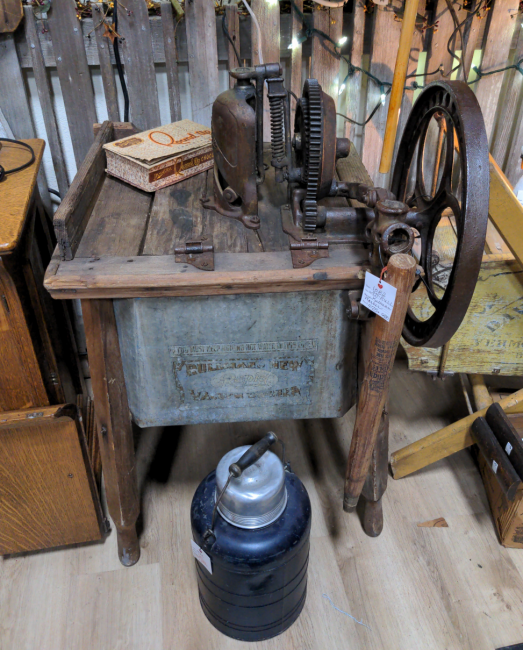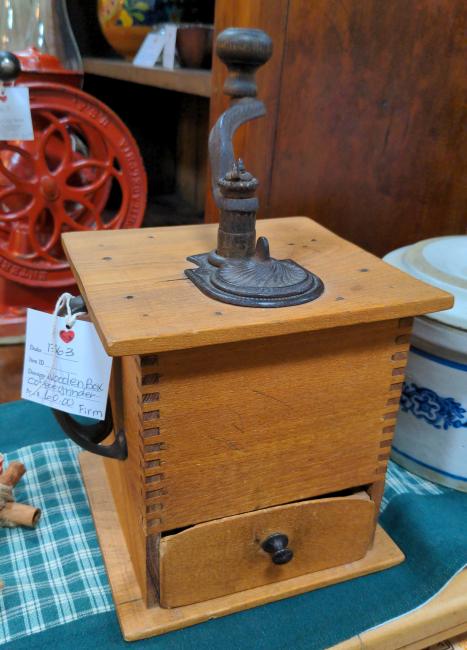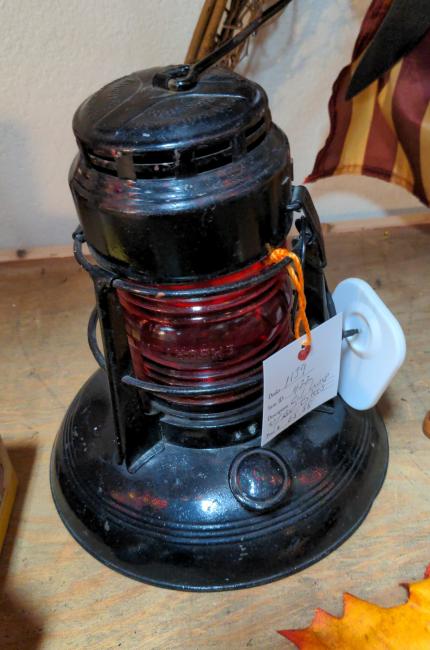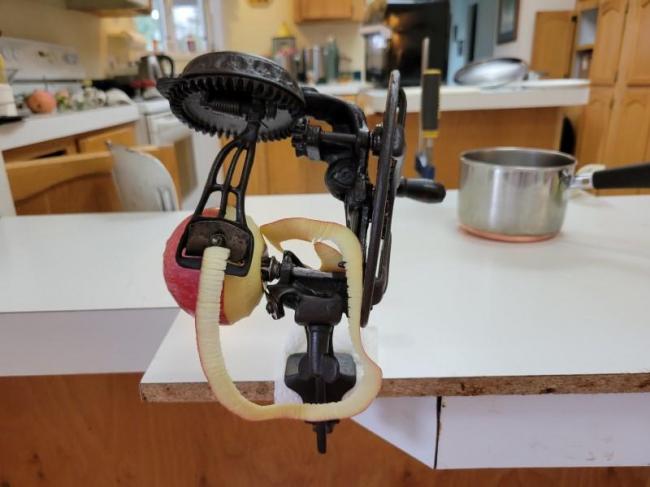Antique store hunting, can I find better preps from the past?
This is going to be a picture dump of my most recent trip to an antique store. I love to go to these places and see the ingenuity of the past and how things have evolved over time. Some items have improved with time, and some have gotten worse and the antiques are actually better than what can be found today. Here are some items that stood out to me on my last trip:
Believe that this is a manual powered drill. The end looks like a shoulder pad to give you someplace to put pressure down on the piece you are drilling.
Dietz kerosene lantern for light and warmth
If you grew your own cotton or raised sheep and learned how to use a spinning wheel, you could be very popular on your block after SHTF when you are the only one who can make clothes.
I saw a few of these torches and was very curious on what kind of fuel they burned and how they worked. Does anyone have any insight on these? It looks like there is a little pump that you will pressurise.
Manual hand mixer for baking
Hand crank butter churn. Butter is the best!
Kerosene powered space heater
Hand crank manual powered clothes washer. Isn’t this so cool!? I would like to have tried this out.
hand crank coffee grinder
I had fun looking at all this neat old stuff and imagined myself having to use these in a non-electric world.
Do you have any vintage machines or gear that you keep around for prepping?
-
Comments (20)
-
Kira - January 13, 2022
The simplicity and durability (and style) of these are really cool!! As I move past the basics, learning old-school crafting is high on my list of things to try. I have a few skills under my belt, but there’s always more to learn! No properly vintage or antique preps yet, but I do have a lot of new old-fashioned tools like my mortar and pestle.
I’d be curious to know how many of these are still functional. My concern with these would be how replaceable any worn or damaged parts would end up being. That drill head looks like it might have seen better days, but that could also just be the angle. A few, like the whisk or coffee grinder, you can get away with an even simpler design that eliminates potentially jammable or breakable gears. (Though I’m sure the gears make keeping a high speed much easier.)
The learning curve for shifting from electric to manual is also going to be steep. I can use an electric pottery wheel all day long, but I would need a lot of practice with a kick wheel (exactly what it sounds like) to make a decent pot.
Do you have anything like this in your preps yourself?
-
Robert LarsonContributor - January 14, 2022
My mom actually has that exact coffee grinder and I remember seeing that while growing up. She has an old cast iron clothes iron as well. Both not necessarily going to keep you alive and are more of decoration now.
I inherited some old probably 1960’s power tools that I have since replaced. They only had one speed and had the old 2 prong outlet. My new drill has variable speed and a safer power cord.
-
-
Pops - January 14, 2022
I love tools, and I like antiques. When we first bought the farm I would go to farm and estate auctions to find old manual farm tools because I wanted to experiment with old, pre-fossil-fueled ways. What I found was old stuff is quite fashionable to hang on the suburban family room wall. A well worn corn sheller, say, would fetch $50 or $60. After a bit I started recognizing folks at every sale, there to buy for resale in their antique stalls.
But one thing you can say about the modern world, if there is any slight demand out there, someone is trying to fill it. Just for fun I googled “corn sheller” and got hits from $8 on up including brand new reproductions with ball bearings and nice castings for $115. Modern production methods and materials like stainless on “old” style manual tools can be the best of both worlds and the ultimate prep.
I still have some old carpenter’s tools I’ve kept but I auctioned off the big stuff when we sold the farm—Now I’ll just have to go out and collect more for the next place!
-
Barb LeeContributor - January 14, 2022
I love antiques though I don’t have many. I recently refurbished a couple of antique lanterns and learned a lot about them. That Dietz lantern is new, made in China, on the old pattern. It is a “cold blast” lantern. Those tall supports are actually air channels that funnel fresh air to the flame and prevent the mixing of combustion products with the fresh air, giving a brighter light. Best used indoors with a very clean, high quality lamp oil or kerosene substitute. I’ve got an old Aladdin lamp that puts out excellent light, and a really good antique clothes wringer. I’d really like to have that hand mixer in your picture!
-
Robert LarsonContributor - January 14, 2022
Thanks for teaching me more about lanterns. I like the red globe of this other lantern I saw at the store.
-
Forager - January 14, 2022
In the bottle collecting world those are called signal or railroad lanterns, but I’m not sure whether that reflects their real or only use. A prepper could probably collect all the colors and then make up a code for what they mean. Unlikely to be useful, but a fun concept:)
-
Robert LarsonContributor - January 15, 2022
That is a good concept of using it to signal different things in a prepper community. Maybe a red lantern in the window signifies danger or to be alert.
-
-
Forager - January 14, 2022
Yes the first item is a drill. I have one, but find it difficult to use compared to either a power drill or a brace and bit. You have to hold it perfectly still while drilling, which isn’t easy. The one advantage to it over a brace and bit is that the chuck can take ordinary drill bits, while the square based bits for a brace are getting increasingly hard to find.
I’m not sure what those torches are, but I for one would not be brave enough to fire them up. Some tools have actually gotten better, with the addition of modern safety features, and I suspect anything dealing with flammable fluids under pressure may well fall into that category.
My best antique store finds have been a hand cranked meat grinder for $4, and some nice sturdy old chisels and gouges for about the same price as flimsy modern ones. All needed a lot of sharpening, but are in good working order now.
-
underprepraccoon - January 19, 2022
Yeah, the drill is what’s called a belly drill, it’s normally used horizontally and you use your belly to really bear down on it.
I personally use a lot of old, restored tools. I have a Disston saw thats at least 100 years old. Rips oak like a beast. Plus the usual number 5s and an old rabbet plane, old socket sets and some brace bits.
Here’s a good video about modernized brace bits
I’ve moved from trying to buy an impact driver to just using a 3/8ths speed tool with the right socket. It’s a little bit of effort, but driving 3 inch deck screws with a hand tool is pretty fun.
Thrifting for tools can be great when you know what you’re looking at
-
-
liebrecht - January 14, 2022
First, antique wheels can be warped, missing parts/ parts worn and new wheels have extra parts available. And usually spin better. Next, friend just bought me 2 new graters as we go thru a LOT of grated cheese. Both the new ones…..stunk. So I pulled out my normal grater…that was my Grandma’s so 100 years old, give or take. It gets pulled out to grate about 3-5 pounds of cheese every other month or so. So far so good<smile>. My life includes 7 spinning wheels, 7 looms, floor and table and specialty. Lots and lots of fibers. Hand shears for shearing sheep/goats to hand sewing items. A lot of my non electric things are used now on a regular basis. Butter churns, while nice, can easily be a jar with a lid that you assign kiddos to shake. I did use a pasta machine to teach the kids to make pasta but I learned from my Grandma with….a rolling pin. Pizza from scratch here can easily be dough, sauce and cheese, all made from “ingredients”. We make soap 1 or 2 times a year. Yes, I like my cordless drill. Yes, I like my TV and computer. I love pushing a switch and lights come on or a handle and water comes out of a faucet. But my cast iron dutch oven can go on an electric stove or make bread in a fire outside. Hand milking a goat/cow is easy once you get the muscles used in shape. But having a freezer for the ice cream bowl when you have fresh cream, works for me.
liebrecht
-
Robert LarsonContributor - January 14, 2022
Where do you put 7 spinning wheels and looms!? They aren’t exactly small items.
Good to know that old antique ones might be warped.
-
liebrecht - January 14, 2022
LOL. Okay…my fast wheel ( alpaca on that one right now) and an Ashford live in the ballroom as I am inclined to spin when the boys practice piano ( also in the ballroom). The other wheels are usually displayed down the hall next to the stairs. Then I can pull out the correct one for certain projects.
The big floor loom lives in the solarium as the light is good in there. The smaller floor loom lives in the library as it fits exactly right under the window. The inkle lives on the mantle in there. The table looms and sample loom, which are used less, live in the solarium also. The rigid heddle lives there. The hand made from exotic woods tape loom lives in the guest room on display. I admit I have a whole storage building that has <ehem> a LOT of fibers and yarns. Tho I do currently have 22 fleeces that need to be prepped and inventoried right now.
Sewing/knitting/crochet/etc ( small projects) live in their own rooms, one for working and one is just storage for fabrics, etc.
liebrecht
-
-
Barb LeeContributor - January 14, 2022
This ancient apple peeler really rocks!
-
Robert LarsonContributor - January 14, 2022
That’s pretty cool! Can it peel other things like a potato or cucumber?
-
Barb LeeContributor - January 14, 2022
I haven’t tried peeling a potato, but a cucumber wouldn’t work – the thing being peeled has to be quite firm to stay on the three prongs. If I had the blades professionally sharpened (the main one is like a utility knife blade) it might have a chance with a small, well formed spud.
-
-
BrewIt - January 14, 2022
I came upon this knife sharpener at my mom’s house. It once belonged to my grandfather. I’m in my 60’s so you can guess how old it is. Stills works like a charm.
-
Clark Thompson - January 14, 2022
Of the devices you’ve illustrated, I’d suggest the kerosene space heater be retired. Modern space heaters are significantly safer — just not worth the risk unless it’s all that’s left between you and freezing.
Crank washers — look for any signs of rust, or give up on having white clothes ever again. We used to spend the summer on an island where power went out with every storm, sometimes for many days and every house had a crank washer or wash tub and board and a mangle and clothes line, Hurricane lamps and a kerosene or wood stove as backup.
US blow torches used gasoline, European used kerosene. The US ones are much more dangerous.
That spinning wheel is for wool, not cotton. Old spinning wheels are typically for wool unless they are for flax with a cage like thing on the distaff for the flax fibers. Flax wheels are usually smaller too.
Hand crank coffee grinders are cool, but you can get whatever grind you want with two slightly different size cast iron skillets. The hand crank ones with a side wheel are easier to use because they keep spinning with momentum.
Half the tools in my shed were my grandfather’s and over 50 years old, does that count?
-
Robert LarsonContributor - January 15, 2022
I had my suspicions about the kerosene space heater and if the technology has been unchanged over the years or if newer ones were safer, so thank you for commenting on that.
That clothes washer was pretty beat up and would need a lot of refurbishing to be able to be something that can be used. That would be a shame to have all your whites ruined by rust.
The blow torch used gasoline!? That is surprising. I’m going to have to look up some videos on YouTube of someone using one just to peak my curiousity.
-
Robert LarsonContributor - January 15, 2022
So I looked up two videos and this one shows the flame best. He uses coleman camp fuel but the other video uses gasoline. Very interesting and cool technology.
-
Clark Thompson - January 15, 2022
Coleman fuel is gasoline, it’s just very low octane with no additives. Safer from an inhalation perspective.
-
Greg P - January 15, 2022
Good to know – (aha) that’s why my manual says that you can use gasoline. I have two old Coleman camp stoves – both are about 50 years old; one belonged to my late father-in-law & the other to my late Dad. They both still work like a champ – they were both careful with equipment maintenance/cleaning.
-
Robert LarsonContributor - January 15, 2022
I didn’t know that Coleman camp fuel was gasoline either. I wonder how much of that actually gets into your food or if it is burned cleanly enough.
-
liebrecht - January 15, 2022
Spinning wheels spin what the owner needed them to spin. A distaff may have a cage but may also be a “spindle” that you tie the flax onto with ribbons. Flax is a PITA to spin tho<smile>. And on the topic….there are many many more spinning tools/toys. Cards, wool or cotton, various types of combs, hackles and niddy noddies, reels and hand spindles, high whorl and low….TOYS! I have a Russian comb used to make yarns for Orenburg shawls and that is an unusual type comb. Flickers and taklis…then you get to types of sheep and exotic fibers….next dyeing and weaving and weaving toys. The list can go on and on<smile>.
liebrecht
-
-
- News for the week of 2025-07-07 - 5 days ago
- Fun ways to teach kids outdoor/survival skills - 2 weeks ago
- News for the week of 2025-06-30 - 2 weeks ago
- News for the week of 2025-06-23 - 3 weeks ago
- News for the week of 2025-06-16 - 3 weeks ago
This forum is heavily moderated to keep things valuable to as many people as possible. Full community policies are here. The basics:
- 1. Be nice to each other.
- 2. Stay focused on prepping.
- 3. Avoid politics, religion, and other arguments.
- 4. No unfounded conspiracies, fake news, etc.
- 5. Debate ideas, not people.
